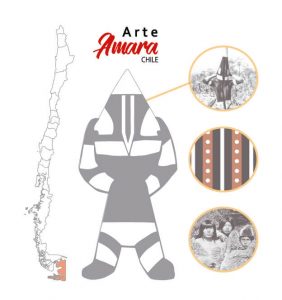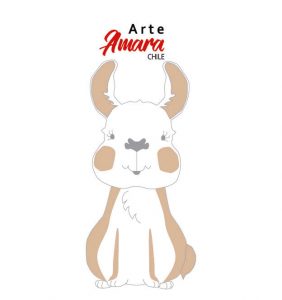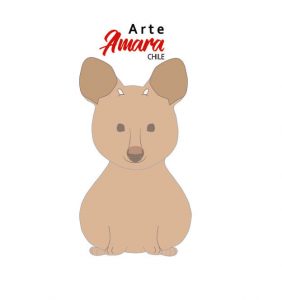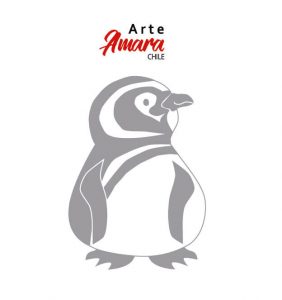CULTURA AYMARA – NORTE DE CHILE
Es: Se ubican en las Regiones de Arica y Parinacota y Tarapacá. Se reconocen por su música andina y sus tejidos de alpaca, vicuña o llama realizados generalmente con colores vivos. Su lengua es el Aymara.
En: They are located in the North Regions. They are known for their Andean music and their alpaca, vicuña or llama fabrics, usually made with bright colors. Their language is the Aymara.


CULTURA DIAGUITA – NORTE DE CHILE
Es: Se ubican en las Regiones Atacama y Coquimbo. Se reconocen por sus grandes habilidades en la alfarería. Famosos son sus “Jarros Patos” y los diseños geométricos. Sus tejidos eran principalmente de llama. Su idioma era el kakán.
En: They are located in the Atacama and Coquinbo Regions. They were famous for their great skills in pottery. The more disntintive are the “Jarros Patos” with their intrincated geometric designs. Their fabrics were mainly made of Llama wool. Their language was Kakán
CULTURA RAPA NUI – CHILE INSULAR
Es: Se ubican en la Isla de Pascua o Rapa Nui. Se reconocen por su música, danza y tatuajes. Aquí se encuentran las famosas estatuas de piedra llamadas Moais. La escritura antigua se llama Rongo rongo y son glifos escritos sobre tablillas de madera.
En: They are located on Easter Island or Rapa Nui. They are recognized for their music, dance and tattoos. Here there are the famous stone statues called Moais. The ancient script is called Rongo Rongo and they are glyphs written on wood tablets.


CULTURA MAPUCHE – SUR DE CHILE
Es: Se ubican en la Región de la Araucanía. Es el pueblo más numeroso del país. Sus casas se les llama “rukas” y su idioma es el “mapudungun”. El palín es un juego comunitario y se usa un palo o Wüño y una bola de cuero llamada Pali. Mantienen viva sus tradiciones tales como las ceremonias del Machitún, Nquillatún y el We Tripantu. Su arte más conocido es la orfebrería y los tejidos. Las autoridades más importantes son el Lonko y la Machi. El kultrún es el instrumento musical más sagrado e importante de los mapuche.
En: They are located in the Region of Araucanía. It is the most numerous town in the country. Their houses are called “rukas” and their language is “Mapudungun”. The palín is a community game and uses a palo or Wüño and a leather ball called Pali. They keep alive their traditions such as the ceremonies of Machitún, Nquillatún and We Tripantu. Their best known art is goldsmithing and weaving. …The most important authorities are the Lonko and the Machi. The kultrún is the most sacred and important musical instrument of the Mapuche.
CULTURA SELK’NAM – CHILE AUSTRAL
Es: Se ubicaron en la Región de Magallanes , en lo que es la Tierra del Fuego. Tenían un profundo sentir espiritual representado en las ceremonias; la principal se llamaba Hain. Un rito de iniciación a la edad adulta. Son conocidos por sus pinturas corporales que usaban para acompañar a sus ritos. También se les llama Onas (hombres del norte) palabra acuñada por sus vecinos los Yaganes. Hoy en día, existen descendientes de la etnia que buscan reivindicar a sus antepasados y ser reconocidos por el Estado Chileno, como un pueblo originario no extinto.
En: They were located in the Magallanes Region, in what it is Tierra del Fuego. They had a deep spiritual sense represented in the ceremonies; the main one was called Hain. A rite of initiation into adulthood. They are known for their body paintings they used to accompany their rites. They are also called Onas (men of the north) word coined by their neighbors the Yaganes. Nowadays, there are descendants of this ethnic group that vindicate their ancestors and want to be recognized as a non-extinct people by the Chilean State.


DISEÑOS DE FAUNA CHILENA - LLAMA
Es: La llama es una subespecie del guanaco. Vive en el altiplano, en la zona cordillerana del Norte de Chile entre las regiones de Tarapacá y Antofagasta, a una altura sobre 2.300 m a los 4.000 m. También está presente en la XII región. Fue domesticado hace 4500 años y es la más grande de entre estas especies. Puede medir entre 150 a 190 cm de alto y pesar hasta 140 kilos. Existe una gran variedad de colores y tonalidades de pelaje. Su cabeza es pequeña y se distingue porque la punta de sus orejas se curva hacia adentro. Tiene el cuello alargado y su cuerpo es esbelto.
En: The Llama is a subspecies of the guanaco. It lives in the altiplano, in the mountain range of the North of Chile between the regions of Tarapacá and Antofagasta, at an altitude of 2,300 m at 4,000 m. It is also present in the XII region. It was domesticated 4,500 years ago and it is the largest of these species. It can measure between 150 to 190 cm tall and weigh up to 140 kilos. It has a great variety of colors and shades of fur. Its head is small and it is distinguished because the tip of its ears that curve inwards. It has an elongated neck and its body is slender.
DISEÑOS DE FAUNA CHILENA - CÓNDOR
Es: El cóndor es el ave más grande de Chile con una longitud de 120 cms. y hasta 3 metros de envergadura. Puede llegar a pesar 12 kilos. Su cuerpo está cubierto de plumas negras con un collar de plumas blancas sobre el cuello y en parte de sus alas. Su cabeza y parte del cuello están desnudos y el macho posee una gran cresta rojiza sobre el pico. En Chile lo podemos encontrar desde Arica hasta Cabo de Hornos en las altas montañas hasta los 5000 metros de altitud. El cóndor prefiere descansar en altura, sobre los acantilados de los Andes y puede volar hasta 300 km. en un sólo día. Puede vivir hasta 50 años o más lo que lo hace ser una de las aves más longevas que existen. Es un animal carroñero y se alimenta principalmente de la carne de guanacos muertos. Debido al impacto humano y al error de creer que ataca al ganado, su población se ha visto diezmada dejándolo en grave peligro de extinción. En Chile está prohibida su captura y caza.
En: The Condor is the largest bird in Chile with a length of 120 cms. and up to 3 meters in span. It can weigh 12 kilos. Its body is covered with black feathers with a necklace of white feathers on the neck and part of its wings. His head and part of the neck are naked and the male has a large reddish crest on the peak. In Chile, we can find it from Arica to Cape Horn in the highlands mountains up to 5,000 meters of altitude. The condor prefers to rest in height, on the cliffs of the Andes and can fly up to 300 km. in one day. It can live up to 50 years or more what makes it one of the longest living birds that exist. It is a scavenger and feeds mainly on the flesh of dead guanacos. Due to the human impact and the error of believing that it attacks cattle, its population has been decimated leaving it in serious danger of extinction. In Chile its capture and hunting is prohibited.


DISEÑOS DE FAUNA CHILENA - ZORRO CULPEO
Es: El zorro culpeo, o zorro colorado, es el zorro más grande de Chile. Puede vivir en un amplio rango de hábitats como desiertos, pampas de matorrales y bosques. Se encuentra a lo largo de los Andes de América del Sur, desde Colombia hasta Tierra del Fuego en Chile. Mide entre 80 a 120 centímetros de largo y puede pesar hasta 12 kg. Tiene un pelaje de color amarillento y su cola es gruesa y la punta ennegrecida. Es un animal muy activo durante el día, pero cuando se trata de cazar, prefiere la noche. Su alimentación se basa en fruta, roedores, aves, liebres y crías de guanacos y de ovejas. Su especie se encuentra amenazada principalmente por el hombre ya que intenta proteger a sus rebaños de este pequeño depredador.
En: The Culpeo fox, or red fox, is the largest fox in Chile. It can live in a wide range of habitats such as deserts, scrub pampas and forests. It is found throughout the Andes of South America, from Colombia to Tierra del Fuego in Chile. It measures between 80 to 120 centimeters long and can weigh up to 12 kg. It has a yellowish fur and its tail is thick and the tip blackened. It is a very active animal during the day but, when it comes to hunting, it prefers the night. Its diet is based on fruit, rodents, birds, hares and guanacos and sheep. This species is threatened mainly by the man as he tries to protect his flocks from this small predator.
DISEÑOS DE FAUNA CHILENA - PUMA
Es: El puma o pangui, pangue es el carnívoro terrestre más grande que habita en Chile. Es un animal territorial, de hábitos solitarios y nocturnos, aunque también puede ser visto a pleno día. Puede medir hasta 2.8 metros de largo, 80 cms. de altura y pesar 80 kilos. Su cabeza es redonda y sus orejas erguidas. El color de su pelaje puede variar de entre rubio, amarillo-grisáceo hasta el Pardo-rojizo. En Chile habita la especie conocida como “Puma concolor puma” desde Arica hasta el extremo sur en Magallanes. Se alimenta de cualquier animal que pueda cazar como guanacos, aves, roedores y ciervos como el pudú y el huemul. Es una especie vulnerable, pero está protegido por ley por lo que su caza y captura está prohibida en Chile desde la década de 1980.
En: The Puma or pangui, pangue, is the largest terrestrial carnivore that lives in Chile. It is a territorial animal, of solitary habits and nocturnal, although it can also be seen in broad daylight. It can measure up to 2.8 meters long, 80 cm. of height and weigh 80 kilos. His head is round and his ears are erect. The color of its coat can vary from blond, yellowish-gray to reddish-brown. In Chile inhabits the species known as “Puma concolor puma” from Arica to the southern tip in Magellan. It feeds on any animal that it can hunt as guanacos, birds, rodents and deer such as pudu and huemul. It is a vulnerable species but it is protected by law so its hunting and capture is prohibited in Chile since the 1980s.


DISEÑOS DE FAUNA CHILENA - PUDÚ
Es: El pudú, de la familia Cervidae, es el más pequeño de los ciervos de América. Tiene un tamaño de 40 cms. de altura. Pesa aproximadamente 10 kgs. Su pelaje varía de café rojizo (el más común) a grisáceo amarillento. Se caracteriza por ser muy tímido. Cuando busca alimente, generalmente sale sólo de noche. Aunque su mayor enemigo natural es el puma, su caza indiscriminada lo ha convertido en una especie con serio riesgo de extinción. Se puede encontrar desde Curicó hasta la Región del Biobío. Y más profusamente desde la Región de la Araucanía hasta Aysén. Es más abundante en la Isla de Chiloé. Habita en bosques y matorrales muy densos.
En: The pudu, of the Cervidae family, is the smallest of the deer in America. Its size is about 40 cms. tall. It weighs approximately 10 kgs. Their fur varies from reddish brown (the most common) to yellowish grayish. It is characterized by being very shy. When looking for food, it usually comes out only at night. Although its greatest natural enemy is the puma, its indiscriminate hunting has turned it into a species at serious risk of extinction. It can be found from Curicó to the Biobío Region sporadically; and more profusely from the Araucanía Region to Aysén. It is more abundant on the Island of Chiloé. It lives in very dense forests and thickets.
DISEÑOS DE FAUNA CHILENA - PINGÜINO MAGALLÁNICO
Es: El pingüino de Magallanes habita desde Coquimbo hasta Cabo de Hornos y Tierra del Fuego. Lo podemos encontrar en zonas costeras e islotes rocosos. Mide unos 70 cms de alto y pesa entre 4,5 a 5 kilos. Su cabeza y la parte posterior del cuerpo es de color negro y en su parte frontal se distinguen áreas blancas además de su característico collar en forma de U invertida color negro. Se alimenta de peces y algunos crustáceos. Está categorizado como “casi amenazado” y, en Chile, está en veda extractiva por Ley hasta el 9 de noviembre de 2025. En nuestro país existen áreas marinas costeras catalogadas como santuarios donde podemos encontrar colonias de pingüinos de Humbolt y de Magallanes y que son administradas por Conaf y/o Sernapesca.
En: The Magellanic penguin lives from Coquimbo to Cape Horn and Tierra del Fuego. It can be found in coastal areas and rocky islets. It measures about 70 cm high and weighs between 4.5 to 5 kilos. Its head and the back of the body is black and on the front there are white areas in addition to its characteristic black inverted U-shaped necklace. It feeds on fish and some crustaceans. It is categorized as “almost threatened” and, in Chile, the season close is set by law until November 9, 2025. In our country there are coastal marine areas classified as sanctuaries where we can find colonies of Humboldt and Magellanic penguins and they are managed by CONAF and/or SERNAPESCA.



